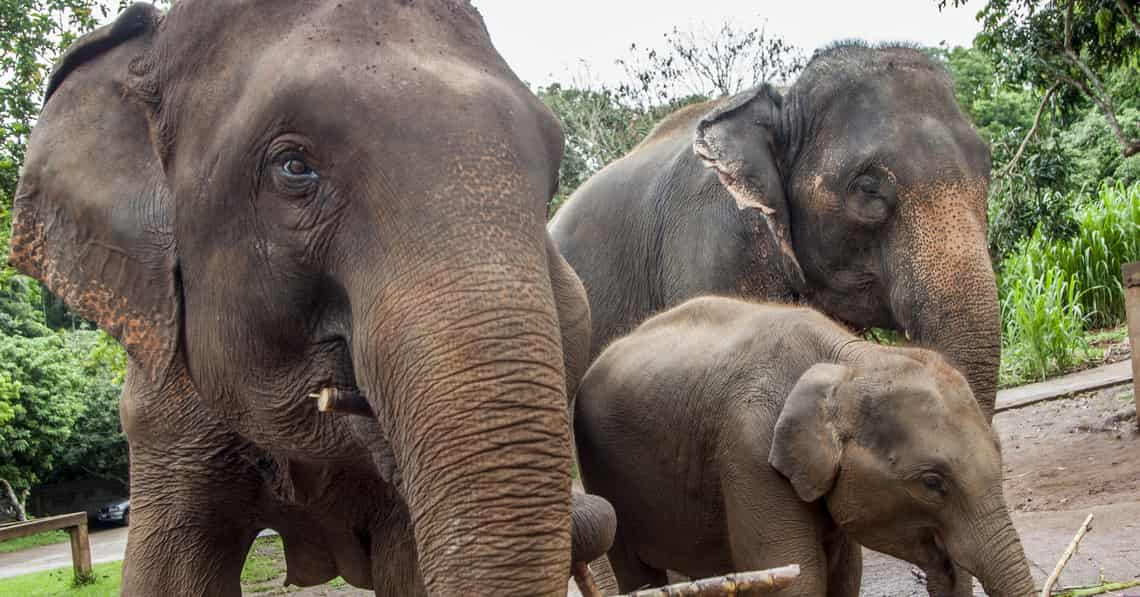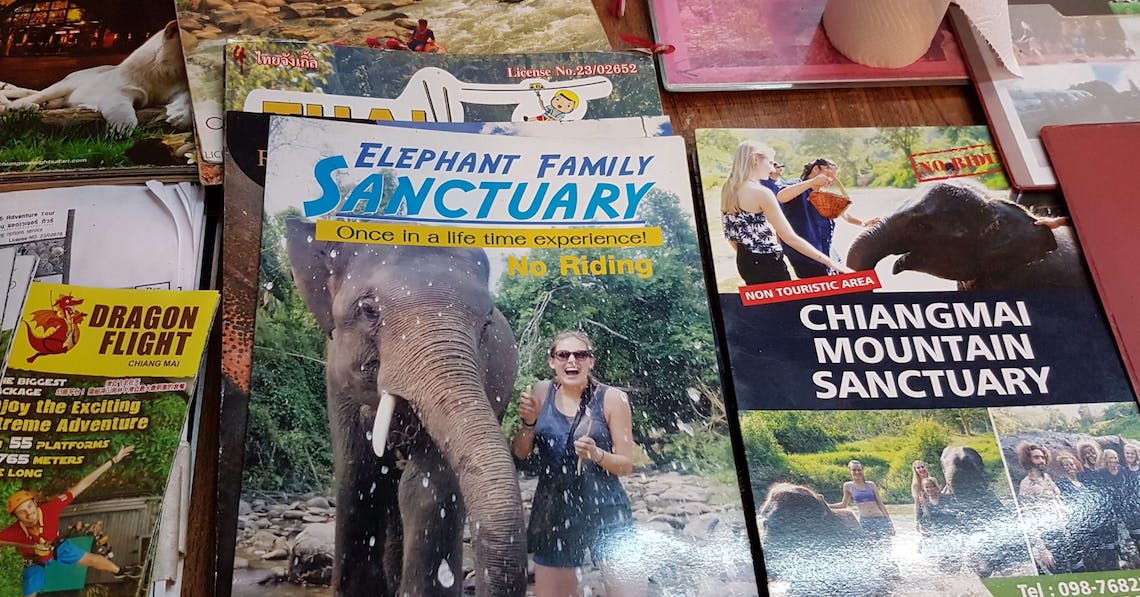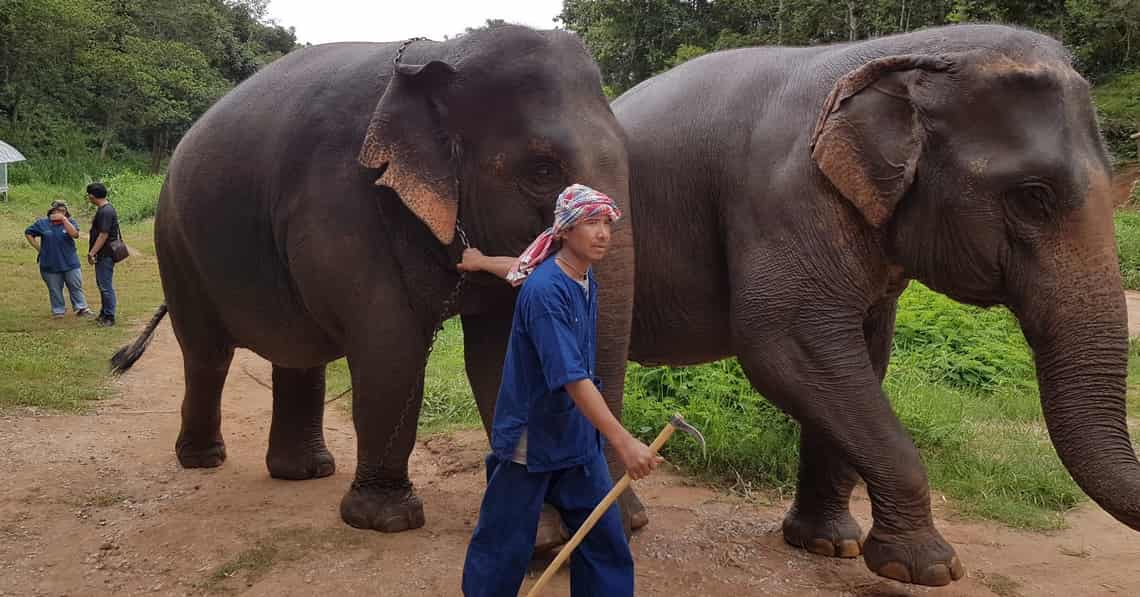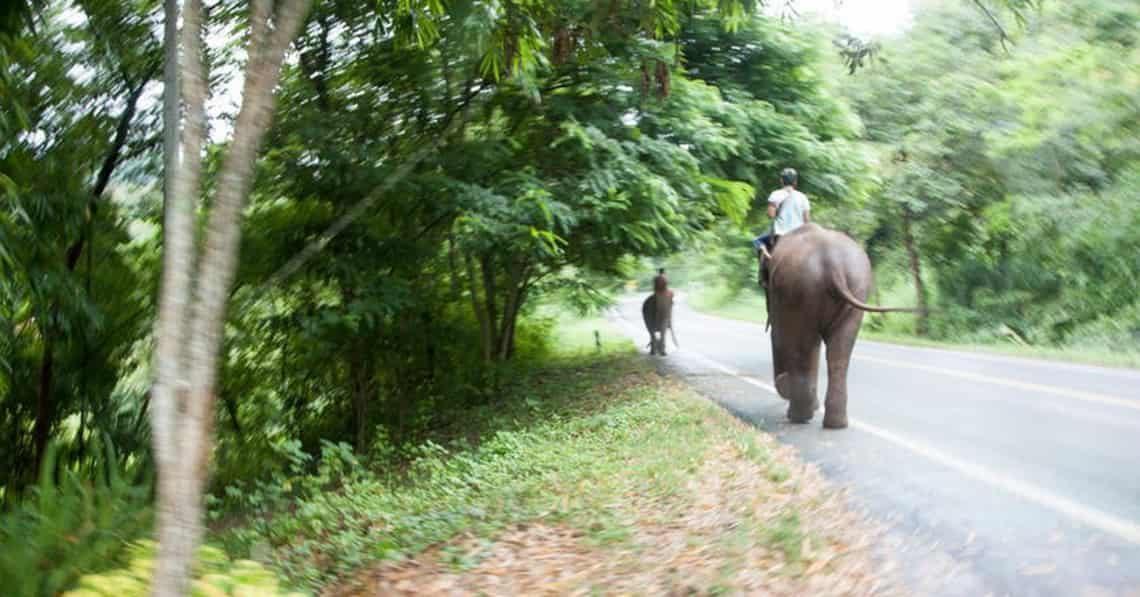Thailand has had a long and close relationship with its elephant population, so much so that we even have a National Elephant Day on March 13th. Though elephants were ridden like horses and used for labour like buffalos, they were also highly regarded, even revered, animals, with some Buddhist beliefs going so far as to claim that elephants are the only animals that can be reborn as a future Buddha. Elephants have been fundamentally associated with ancient religious rituals and the monarchy for centuries; being symbols of legitimacy, prestige and power for all political aspirants.
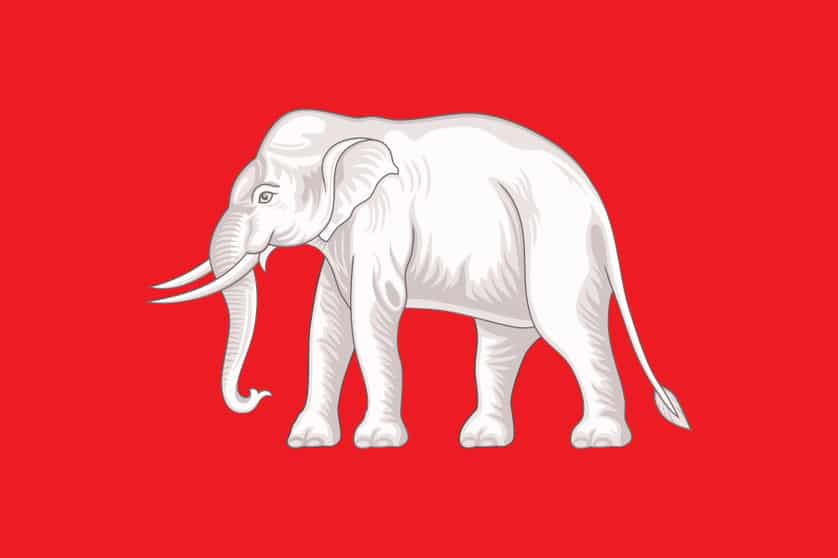
King Rama II’s national flag of 1817 featured his white elephant (the flag was changed to its current form one hundred years later) and elephants played a considerable role as a royal vehicle in both traditional warfare and ceremonies. Yet our elephant population has dwindled from one hundred thousand at the turn of the last century, to under 5,000 including about 3,600 in captivity today. The question isn’t, therefore, what happened to our elephants; but how on earth we allowed this to happen?
Riches to Rags
Elephants have been domesticated in Asia for the better part of four millennia, though in Thailand records only go back around a thousand years. In the past, elephants would roam in wild herds, occasionally being selected for capture and training in preparation for war, only to then be released into their natural habitats afterwards. There were of course domesticated elephants in permanent captivity for other purposes such as transport and labour, but this unnatural selection continued for hundreds of years, generally keeping the population steady and the elephant’s relationship with man semi-domesticated. It wasn’t until the late 19th century, when western powers, mainly British, began to gain teak logging concessions in the region that vast numbers of elephants were captured from the wild, made captive and used in labour.
Witaya Khem-nguad of the Thai Elephant-Assisted Therapy Project explained, “Teak trade was the majar income for the nation for many decades. Following the end of absolute monarchy in 1932, teak concessions were transferred from the Royal Court Property to the government. The government set up the Forest Industry Organisation (FIO) in 1947 which oversaw all logging concessions, making deals with trading companies such as the Bombay Burmah Company, and overnight becoming vastly wealthy as well as the largest ownership of elephants in the nation.”
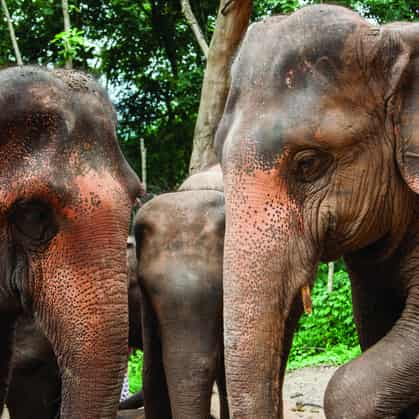
The FIO prospered, as did logging companies, until wide scale deforestation led to calamitous flash floods in the south of Thailand in late 1988, which triggered a nationwide logging ban through an emergency decree in January 1989. Suddenly at least 2,000 logging elephants were unemployed. Coincidentally it was at the same time that Asian elephants were declared an endangered species by the Convention in International Trade in Endangered Species of Wild Fauna and Flora (CITES), mainly due to lack of habitat following the vast population growth in the region over the last century. This declaration also forced Thailand to begin to conform to changing international standards, leading to its ban on ivory trade around the same time.
With FIO and many elephant owners facing massive financial loss (the FIO took approximately 293 million baht per annum between 1973 and 1990, its funds slumping to 25 million by 1992), elephants became prohibitively expensive to maintain. Suddenly, with our cities’ streets flooded with ‘begging elephants’, or rather elephants used by their mahouts who could no longer feed their charges to solicit for food and donations, coupled with the world’s focus on the endangered status, elephants became a part of the national dialogue. This was also the time when elephants began to be seen through scornful eyes of pity, rather than those of respect and revelation. The exodus of elephants from mystical jungle creatures to ubiquitous and pathetic street beggars led to international condemnation and a nation surprised by an embarrassing problem with few immediate solutions.
According to Golden Triangle Asian Elephant Foundation, the cost to maintain an elephant is round 540,000 baht per year. An elephant needs to eat about 10% of its body weight, or approximately 250kgs every day and then of course there are the costs for facilities, medical care and such. Owning an elephant is expensive, but yet Thailand simply does not have enough wild remaining for them to return — not that domesticated elephants can easily adapt to such a habitat change.
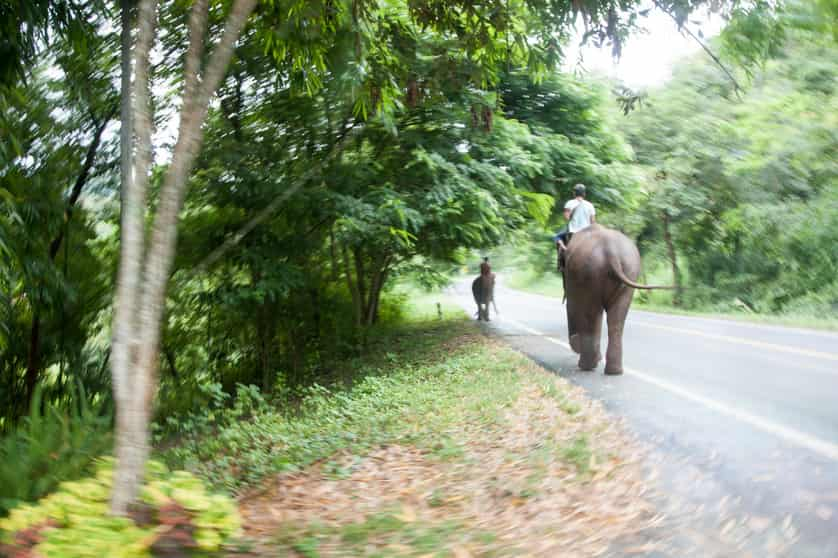
By 1995, the Bangkok Metropolitan Administration had officially prohibited elephants from working its city streets due to both danger as well as fear for losing its reputation, though the ban didn’t go into full effect until the mid-2000s. It wasn’t until HM Queen Sirikit expressed her concern for and wish that elephants be protected that these street elephants were bought and along with their mahouts brought to the Surin Elephant Kingdom where until today 1,000 elephants have been rescued and are used in ecotourism.
Incidentally Surin, home of the Kui ethnic people, believed to have been the first and best in the region at capturing and training elephants, had its first elephant festival in 1960, catching both national and international attention to elephants for tourism purposes, leading to its sponsorship by Tourism Authority of Thailand (TAT) and eventually becoming Thailand’s first elephant camp in 1962.
Career Change
Fortunately, the logging ban come in to effect at the some time that tourism to Thailand began to grow exponentially.
While Chiang Mai had three elephant camps in operation in the late seventies, the nineties saw an explosion in numbers leading to a whopping 77 camps today.
The fate of the elephants in Northern Thailand is explained by Teerapat Trungpakan, the owner of Patara Elephant Farm who said, “After the logging era, some of the elephants retired. Many had crossed the boader and continue logging in Myanmar. It was a hard time for all the elephant owners because they have to earn money somehow. Then it developed to the tourism stage. The first place using elephants for tourism in Chiang Mai was actually Karen villages on the Samoeng Loop which demonstrated to tourists logging skills of elephant. Then Mae Sa and Chiang Dao began to add rides, and it goes on.”
The financially crippled FIO with about 50 elephants under its care, drafted an alternative solution in 1990, and established the Thai Elephant Conservation Centre (TECC) in 1993 located in Lampang and supervised by Dr. Preecha Phaungkum who was a Chief Veterinarian of FIO at that time. Under the necessity to earn revenue, in 1998 TECC integrated with TAT’s promotional programme Amazing Thailand, which boosted the elephant tourism industry.
Righteous and Outraged
At this point, if you are a liberal with a certain viewpoint, you will be gritting your teeth and starting to imagine chained elephants being controlled by steel hooks and made to kick footballs or give endless rides to heartless tourists. This has become the internationally condemned image of Thai elephant tourism and elephant camps. And it is a very false narrative which needs to be changed, according to nearly every expert in the industry we have talked to.
“Everything we think we know about protecting elephants is wrong,” said Carmen Rademaker, founder of Naka Elephant Foundation as well as Asian Captive Elephant Working Group (ACEWG) which is working with experts in the field all over the world to set standards for captive elephants for Asian elephants, of which there are a remaining 15,000.
“It all started with one video,” she explains.
In 2002, People for the Ethical Treatment of Animals (PETA) released footage supposedly filmed in Chiang Mai featuring a monstrous training technique practiced on an elephant, the so called the crush or phajaan. It showed a baby elephant being ripped away from its mother and then constrained, tortured and starved to break its sprit. This video went viral, generated untold donations for PETA and is still believed by many, in spite of no corroborating footage ever since, to be the common practice of training elephants by their mahouts in Thailand. The mantra of the west became, “No chains, no hooks, no rides, no shows — boycott all camps”.
According to ACEWG, such claims are patently false and phajaan was never about training, but merely an ancient ceremony carried out before training to ask spirits for protection of both elephants and mahouts, regardless of training methods. Citylife has also been told by multiple sources, who unfortunately do not wish to be named, that the video was faked.
Dr. Chatchote Thitaram, Director of Centre of Excellence in Elephant Research and Education and also a director at ACEWG explained, “The situation does not work in black and white. There are scared mahouts who act aggressively and then there are those who are committed to ethical methods.”
In the west, elephants in captivity generally live in prohibitively expensive enclosures, being fed food by their handlers. This gives the impression of freedom to roam when compared to the chained elephants whose owners’ other option would be to build cheap, inadequate and potentially dangerous enclosures. In fact, elephants, which tend to feed up to 18 hours per day, are not often chained for long during the day and their 25-30 metres long chains overnight allow them to forage for fresh browse and exercise. So-called sanctuaries (according to ACEWG, none in Thailand meet sanctuary standards) with uncontrolled elephants are also extremely dangerous not only to tourist and mahouts, but also other elephants.
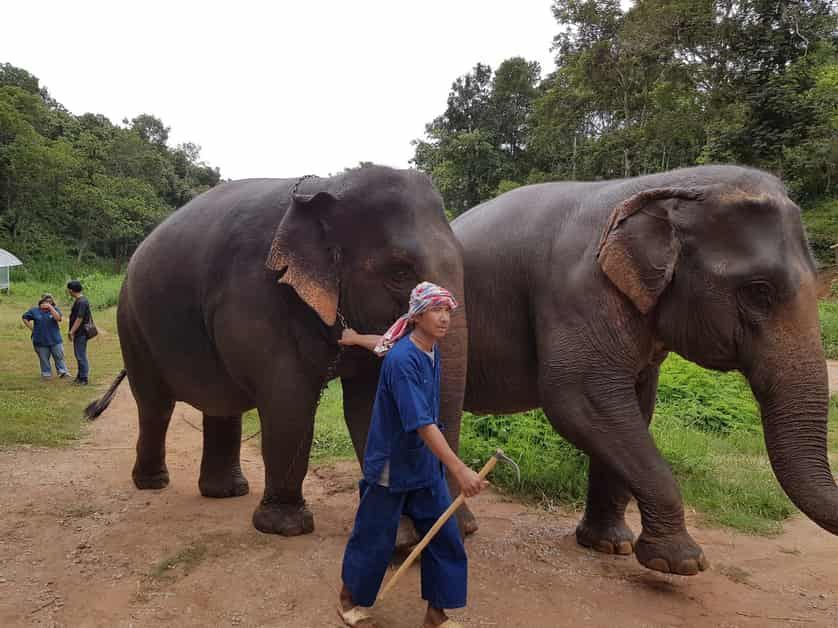
In fact, ACEWG has published a report clarifying the 15 issues that have been condemned internationally in the past decades, including issues of performing tricks, reintroduction to the wild, capability of interaction with humans, walking distances, carrying capability, behavioural stereotypes, and more.
Which brings us to the hot issue of hooks, which according to ACEWG, is a “tool developed over thousands of years to allow a mahout to get an elephant’s attention in an emergency…or to ensure safety.” ACEWG went on to say that not carrying a hook is dangerous for both the elephant and any people around, “as with all tools, the hook can be misused or used purely for punishment, which is not its intended use, which is generally to be tapped onto pressure pointsi.” It is a simple matter of looking at the foreheads of elephants for signs of hook abuse; if there are no scars, then this is a non-issue. Other contentious and greatly misunderstood issues are those of riding, “two people in a saddle is less than 10% of the elephant’s body weight and will not be an undue stressor if ride times are limited,” and of course shows and performances, “as long as they are within their natural skillsets, and using positive training techniques…can benefit the animal’s health,” according to ACEWG.
“It is the same old story repeatedly reused again and again for decades with more drama but less truth,” sighed Rademaker.
“People love to hear that elephants are rescued from unsafe or unsuitable living conditions. But rescuing is just the beginning. We can’t just say, ‘look! We rescued an elephant’ and already we’re the hero. The story is not completed there. Lives of the elephants after rescued can be as challenging as before, same as lives of children after they are fostered. It doesn’t just matter what happened before, once elephants have been rescued, they have the rights to be happier and healthier. Their sad stories are not supposed to be used for emotional donations,” said Teerapat.
Sanctuaries are businesses, just like camps, and profits need to be made. These are the reality of the future of Thailand’s elephants — they need to earn a living. And tourism is, at this point, the only viable solution. As long as standards are set and owners and mahouts as well as tourists are properly educated, elephants should enjoy a healthy and happy future working Thailand’s tourism industry.

Knee Jerks
It was reported by CNN Travel in 2016 that more than 100 tour companies were boycotting elephant rides following World Animal Protection’s campaign.
“Boycotting the elephant camp is only going to make things worse,” said Rademaker referring to the mere 5% of soul-searching western tourists who will actually boycott camps, according to a report by Naka Foundation. The vast majority of tourists seeking elephant tourism are now Chinese and Asians, according to the report, expect to pay less for their experience and seek more showboating and entertainment. “The whole boycott thing is only going to force all the elephant camps to target Chinese or other markets instead,” explained Rademaker.
“The threat is that not many people in those markets actually care about animal welfare. The lower income from low paid tourists will only force the camp to work the elephants harder to earn the same amount of money. It is destructive.”
95% of captive elephants in Thailand, or around 3,400, are privately owned which means that tourism is their only future. Boycotting them is ignorant and dangerous. What should happen is more exposure which will lead to pressure to set and maintain standards of care. The primary law in Thailand regulating captive elephants is the 1939 Beasts of Burden Act, which doesn’t even mention the safety or welfare of the animals. Updating this law and bringing it into the 21st century is the priority for many who care for the future of the Thai elephant.
A Trunk in Hand Future
There are many groups working towards this shared goal and there is beginning to be some strength in numbers and tentatively good news. Citylife attended a workshop in early June organised by The Golden Triangle Asian Elephant Foundation (GTAEF) introducing Target Training, a positive reinforcement training used to reduce the stress of elephants during medical treatment, and we are hearing of more efforts by various foundations and experts in the field who are working together to educate, set standards and hopefully begin to change the negative and false narrative that has been engulfing Thailand’s elephant tourism industry.

Patara Elephant Farm has arguably the best breeding programme of captive Asian elephants in the world, having birthed 36 elephants last year with a projected 34 being born this year. The Thai Elephant-Assisted Therapy Project is successfully exploring ways for elephants to be used in therapy for children with autism and Down syndrome. Groups like NAKA and GTAEF are turning the narrative tide and gaining traction in pooling resources and support from various stakeholders. Travelife, in partnership with Center of Excellence in Elephant and Wildlife Research, Chiang Mai University, ACEWG and various other supporters, are working to set up the Elephant Camp Animal Welfare and Sustainability Standard which they hope will be adopted by elephant camps throughout the region. Mae Sa Elephant Camp, Chiang Mai’s first elephant tourism business, and owner of 80 elephants, has also shown remarkable commitment over the past four years by now offering mahout training courses and certifications which are of a standard acceptable by all parties. It is hoped that others will soon play ball and together we can look forward to a bright and sustainable future with our pachyderm friends.
Related Article: Changing the Narrative for Captive Elephants
If you are interested in learning more about this issue please visit
